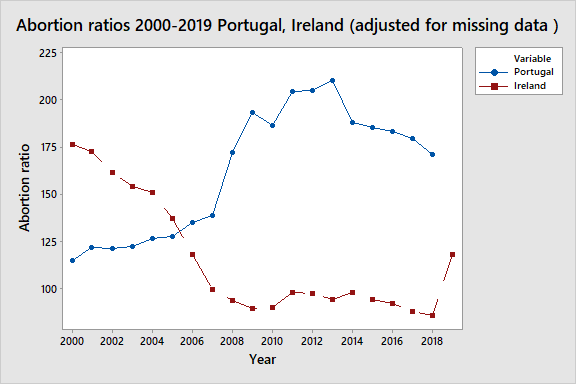By Jim Stack MSc PhD
Two years ago, I wrote an Iona blog comparing historical abortion ratios in Ireland and Portugal. My main purpose at the time was to predict what would happen to abortion numbers in Ireland following repeal of the Eighth Amendment, based on Portuguese experience before and after they legalised abortion in 2007.
In those two years, Ireland has indeed jettisoned the Eighth Amendment and legalised abortion, and also more birth and abortion data have become available for both countries. In particular, we have official Irish birth and abortion data for 2019, the first full year of operation of the new abortion regime here. It seems a good time to take stock i.e. to see what happened, and to consider what may happen next.
Here is the latest data:
The graph above is an extended version of the graph of Portuguese and Irish abortion ratios which featured in my Iona blog of May 2018. No changes have been made to the original graph up to 2015, but data for subsequent years (2016-2019 for Ireland, 2016-2018 for Portugal) are now available and have been included here. As with the earlier graph, the source of the data, up to and including 2018, is the Johnston’s Archive spreadsheets for the two countries, available on the web. The 2019 abortion ratios have not been posted yet, for either country, but I was able to calculate the Irish ratio myself, from the 6666 abortions in the official abortion report for Ireland 2019, and the 375 abortions in England and Wales where women gave Irish addresses. Combining these and comparing to the nearly 60,000 live births here in 2019, yields an abortion ratio of 117.8 for Ireland 2019, which is what has been graphed.
For 2016-2018 Irish data, I made the same upwards adjustment to the reported Irish abortion ratios as I had done in the earlier analysis – a 50% increase in the ratio to account for Irish women giving non-Irish addresses when procuring abortions abroad, and the further addition of 14 to the ratio to account for about 1000 abortions a year by self-administered abortion pills. Given these large upward adjustments, I do not see how anyone could argue that Irish ratios up to 2018 have been underestimated in my analysis.
Concentrating on the recently-added data: it is obvious from the graph above that the ratios declined in both countries, year by year, from 2016 to 2018, and I attribute this mainly to increased use of self-administered pills. It is also notable that this decline is steeper in Portugal than in Ireland, and I think the explanation for this is that I increased the Irish ratios by 14 to account for self-administered abortions, but I did not know by how much to increase the Portuguese ratios, and I left them as they were. Abortion was legal in Portugal 2016-2018, so the number of self-administered abortions is likely to have been lower than in Ireland for these years, but the declining graph above suggests that it nevertheless remained a factor.
By the same logic, the 2019 ratio for Ireland has not been adjusted upward for self-administered pills. I take for granted that this number has dropped in Ireland compared with previous years, but (as I argued in a recent blog) the relatively low official abortion ratio here, compared to Portugal, raises the possibility that we might nevertheless have a continuing problem here with illegally imported pills.
However (and this is my main reason for this update of my 2018 blog), for those of us who opposed repeal of the Eighth Amendment, the graph above provides incontrovertible evidence that we were right to argue that legalising abortion would increase its prevalence. For both countries, the graph takes a sharp upward jump in the year after legalisation – in 2008 in Portugal, and in 2019 in Ireland.
Finally, and entering the hazardous world of statistical prediction once again, there was a steady rise in abortion ratios in Portugal, in five of the first six years following legalisation in 2007– this is clearly evident in the graph above. If we assume that the same thing will happen in Ireland, then we can expect about 9000 – 10,000 abortions per year here in 2025, unless we actively intervene to bring abortion rates down.
—–
Jim Stack MSc PhD, a retired Mathematics Lecturer, has acted as statistical adviser/author on more than forty published, peer-reviewed medical studies (listed on the website PubMed [2] ). He writes here in a personal capacity.
